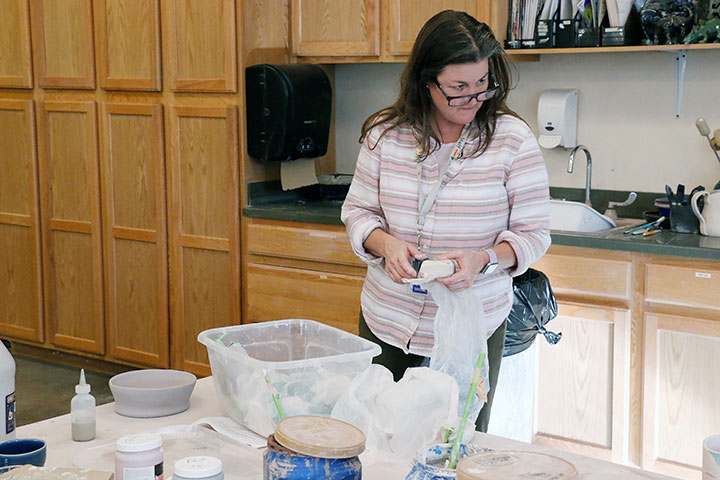Art, music teachers adjust their teaching techniques
Instructors meet the challenge posed by eLearning days
Art teacher Mrs. Sara Greene said she joined several Facebook groups for art teachers to give her ideas for improving her instruction during eLearning days.
The sudden cancellation of in-person classes was especially challenging to teachers who instruct hands-on classes. Few have had to change their classes as drastically as art and music teachers.
Ms. Joellen Desautels, Mr. Jon Kane, Mrs. Sara Greene and Ms. Marian Bender provided their perspective on how they have been able to continue to provide quality instruction to their students during the shutdown.
Desautels, who teaches photography and visual communications, said that she’s had to do “a lot more videos and conference calls.” Her photography classes have been using the camera phones to take pictures. Desautels said, “The biggest difference is that the kids are needing to be more self-sufficient with their problem solving since I am not walking around the room taking questions.”
Desautels said she was surprised when eLearning was announced. She said, “When teachers met and were told that eLearning might happen, I did not think that it was going to happen the next day.”
Desautels said she thought that a lack of student interaction is a problem. She said, “When I am in front of the kids in person, I know the bases are covered. But when I upload documents, videos, slides and tutorials, I am not sure if they are taking advantage of looking at all of it.”
Desautels said she hopes that her independent art students receive some recognition, as they “have been working hard over multiple semesters and some even years,” she said. She noted that despite the challenges, she has been able to maintain academic standards and teach to her curriculum for each course.
Kane teaches drawing, painting, AP Studio Art and IB Visual Art. He said, “Communication is a significant component and explanations and expectations take quite a bit of time and effort to convey clearly.” With the alert that eLearning would start, Kane said, “(I) sent home a packet of art materials with my students.” It ended up not being quite enough, and “students have had to improvise with found materials in some cases,” he said.
Kane added that “this has allowed for some very creative, resourceful and innovative project solutions.” Kane still tries to look at the current crisis in a positive light. He said, “I look at this time as an opportunity to continue to move forward, but in a new way.”
Freshman Anastasia Rearick is enrolled in drawing and added her experience with the class and said Kane “handled (the switch to online learning” well.” She said that one of the assignments was decorating a hard-boiled egg for Easter.
Greene teaches Ceramics 1, 2 and 3, advanced independent 3D art, studio art and design and IB Visual Art and serves as the moderator of the Art Club. She said her classes have changed drastically. She said, “Since we have been out of the classroom and we aren’t working with actual clay, I have reinvented the course to focus more on 3D design.”
Before the closure was officially announced, Greene said, “I did not have a plan in place but I did join quite a few art teaching groups on Facebook and was able to find a lot of interesting ideas.” Greene said that if she had known that the shutdown was to take place, she “would have made sure that each of my students who were interested had clay and tools to be able to keep making projects at home.”
Greene accepted the current state of things by saying that she’s “realized that although I do not like working with Schoology at all, I can figure it out.”
Bender, who serves as the director of choirs, teaches two choir classes, two piano classes and an advanced independent vocal/piano study class. She said that she has been working on what she called a “virtual concert choir project. Each student has sent a recording of themselves singing the song ‘I Choose Love’ by Mark Miller. I then uploaded all the tracks into Audacity and my husband helped line up all the voices. The choir then gathered over Zoom and we recorded the video part. Then, through iMovie, I put together the video/audio.”
For her keyboarding classes, Bender said, “The students have been sending videos of what they are working on and I send feedback. Then, once a week, I try to connect via Zoom for a one-on-one lesson.”
Bender said she thought that music is important for this time of crisis. She said, “Music creates a sense of belonging and participation and is a sort of antidote to the sense of isolation we are feeling.” She also found some good amidst the somewhat dire circumstances. She pointed out that “the silver lining in all of this is that we are spending time with our families, learning how to adapt and I believe that we will come out of this completely changed for the better.”
Kane didn’t see anything as truly impossible to accomplish in an online environment. He said, “eArt takes effort and an open mind from students as well as teachers. As long as both are fully participating, we can make it work — together.”

Liam Eifert is a Senior and the Megaphone co-editor-in-chief. He runs cross-country and track for Cathedral. In his free time, he likes to read, study...







